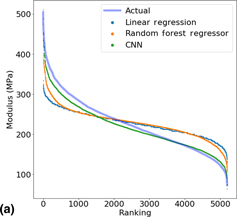Crossref Citations
This article has been cited by the following publications. This list is generated based on data provided by
Crossref.
Wilt, Jackson K.
Yang, Charles
and
Gu, Grace X.
2020.
Accelerating Auxetic Metamaterial Design with Deep Learning.
Advanced Engineering Materials,
Vol. 22,
Issue. 5,
Kim, Yongtae
Yang, Charles
Kim, Youngsoo
Gu, Grace X.
and
Ryu, Seunghwa
2020.
Designing an Adhesive Pillar Shape with Deep Learning-Based Optimization.
ACS Applied Materials & Interfaces,
Vol. 12,
Issue. 21,
p.
24458.
Jin, Zeqing
Zhang, Zhizhou
and
Gu, Grace X.
2020.
Automated Real‐Time Detection and Prediction of Interlayer Imperfections in Additive Manufacturing Processes Using Artificial Intelligence.
Advanced Intelligent Systems,
Vol. 2,
Issue. 1,
Yang, Charles
Kim, Youngsoo
Ryu, Seunghwa
and
Gu, Grace X.
2020.
Prediction of composite microstructure stress-strain curves using convolutional neural networks.
Materials & Design,
Vol. 189,
Issue. ,
p.
108509.
Zhai, Chenxi
Li, Tianjiao
Shi, Haoyuan
and
Yeo, Jingjie
2020.
Discovery and design of soft polymeric bio-inspired materials with multiscale simulations and artificial intelligence.
Journal of Materials Chemistry B,
Vol. 8,
Issue. 31,
p.
6562.
Kollmann, Hunter T.
Abueidda, Diab W.
Koric, Seid
Guleryuz, Erman
and
Sobh, Nahil A.
2020.
Deep learning for topology optimization of 2D metamaterials.
Materials & Design,
Vol. 196,
Issue. ,
p.
109098.
Jacobs, Eric W.
Yang, Charles
Demir, Kahraman G.
and
Gu, Grace X.
2020.
Vibrational detection of delamination in composites using a combined finite element analysis and machine learning approach.
Journal of Applied Physics,
Vol. 128,
Issue. 12,
Chen, Chun‐Teh
and
Gu, Grace X.
2020.
Generative Deep Neural Networks for Inverse Materials Design Using Backpropagation and Active Learning.
Advanced Science,
Vol. 7,
Issue. 5,
Tian, Chenxi
Li, Tianjiao
Bustillos, Jenniffer
Bhattacharya, Shonak
Turnham, Talia
Yeo, Jingjie
and
Moridi, Atieh
2021.
Data‐Driven Approaches Toward Smarter Additive Manufacturing.
Advanced Intelligent Systems,
Vol. 3,
Issue. 12,
Lejeune, E.
and
Zhao, B.
2021.
Exploring the potential of transfer learning for metamodels of heterogeneous material deformation.
Journal of the Mechanical Behavior of Biomedical Materials,
Vol. 117,
Issue. ,
p.
104276.
Kim, Do-Won
Lim, Jae Hyuk
and
Lee, Seungchul
2021.
Prediction and validation of the transverse mechanical behavior of unidirectional composites considering interfacial debonding through convolutional neural networks.
Composites Part B: Engineering,
Vol. 225,
Issue. ,
p.
109314.
Yuan, Shangqin
Li, Shaoying
Zhu, Jihong
and
Tang, Yunlong
2021.
Additive manufacturing of polymeric composites from material processing to structural design.
Composites Part B: Engineering,
Vol. 219,
Issue. ,
p.
108903.
Xiao, Pengwei
Zhang, Tinghe
Haque, Eakeen
Wahlen, Trenten
Dong, X. Neil
Huang, Yufei
and
Wang, Xiaodu
2021.
Prediction of Elastic Behavior of Human Trabecular Bone Using A DXA Image-Based Deep Learning Model.
JOM,
Vol. 73,
Issue. 8,
p.
2366.
Kim, Cheolwoong
Lee, Jaewook
and
Yoo, Jeonghoon
2021.
Machine learning-combined topology optimization for functionary graded composite structure design.
Computer Methods in Applied Mechanics and Engineering,
Vol. 387,
Issue. ,
p.
114158.
Ammasai Sengodan, Ganapathi
2021.
Prediction of two-phase composite microstructure properties through deep learning of reduced dimensional structure-response data.
Composites Part B: Engineering,
Vol. 225,
Issue. ,
p.
109282.
Maurizi, Marco
Gao, Chao
and
Berto, Filippo
2021.
Interlocking mechanism design based on deep-learning methods.
Applications in Engineering Science,
Vol. 7,
Issue. ,
p.
100056.
Park, Donggeun
Jung, Jiyoung
Gu, Grace
and
Ryu, Seunghwa
2022.
A Generalizable and Interpretable Deep Supervised Neural Network to Predict Strain Field of Composite in Unseen Design Space.
SSRN Electronic Journal ,
Paturi, Uma Maheshwera Reddy
Cheruku, Suryapavan
and
Reddy, N. S.
2022.
The Role of Artificial Neural Networks in Prediction of Mechanical and Tribological Properties of Composites—A Comprehensive Review.
Archives of Computational Methods in Engineering,
Vol. 29,
Issue. 5,
p.
3109.
He, Z.C.
Huo, S.L.
Li, Eric.
Cheng, H.T.
and
Zhang, L.M.
2022.
Data-driven approach to characterize and optimize properties of carbon fiber non-woven composite materials.
Composite Structures,
Vol. 297,
Issue. ,
p.
115961.
Ashank
Chakravarty, Soumen
Garg, Pranshu
Kumar, Ankit
Agnihotri, Prabhat K
and
Agrawal, Manish
2022.
Deep neural networks based predictive-generative framework with data augmentation for designing composite materials.
Modelling and Simulation in Materials Science and Engineering,
Vol. 30,
Issue. 7,
p.
075003.
